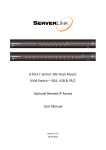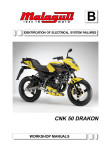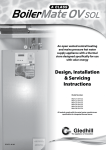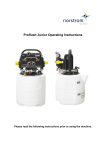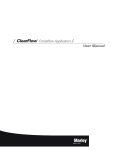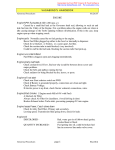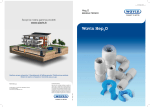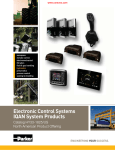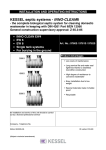Download Kamco CF30 SM
Transcript
The Kamco ‘CLEARFLOW CF30 CLASSIC’ pump is a purpose built unit for ‘Power Flushing’ central heating systems, designed to cure circulation and boiler noise problems caused by the accumulation of sludge, corrosion deposits and scale. This manual contains detailed guidelines for the safe use of the pump. How to connect the pump into the heating system, step by step guide to the flushing process, and which chemicals are best suited for each application. Please take time to carefully read through these guidelines before using your Kamco pump. Kamco Ltd Unit 9 Curo Park, Frogmore, Park Street, St. Albans, Hertfordshire, AL2 2DD Tel: 01727 875020 Fax: 01727 875335 Additional information may be obtained from our website: www.kamco.co.uk Issue: September 2008 SECTION A – INTRODUCTION TECHNICAL DATA Pump Type: Positive drive centrifugal. Motor: 0.45 HP, 220v (#) or 110v. Degree of protection: IP54. Motor rating: Continuous. Temperature range: 0°C to 70°C. Dimensions: Height 63cm, Diameter 41cm. Weight: 14kg. # The CLEARFLOW CF30 220v may be used on a domestic 13 ampere supply. A 5amp fuse should be fitted in the plug top. A residual current circuit breaker adaptor should be used SAFETY PRECAUTIONS Precautions should be taken to ensure a safe working environment. Take care when lifting large or heavy items. Regularly check power leads for wear or damage, use with a residual circuit breaker. When handling chemicals wear suitable protective clothing, gloves and goggles. Use in a well ventilated area. PAT test (Portable Appliance Test) the electrics annually. CONTENTS OF THE CLEARFLOW CF30 CLASSIC KIT Each kit comprises the following: CLEARFLOW CF30 Classic power flushing pump. Set of 2 x 3mtr flow and return hoses. 1 x 8mtr dump hose. 1 x 3mtr overflow hose. 1 x 5mtr water inlet hose. 2 x 2mtr circulation pump adaptor hoses. 10 part BSP adaptor set. Waterproof transit container. Comprehensive operating guidelines. Starter pack of flushing chemicals. 50 promotional leaflets for advertising. Issue: September 2008 Section A – Introduction Page A.1 SECTION B – USING THE CF30 FOR POWER FLUSHING INTRODUCTION The CLEARFLOW CF30 pump is designed to power flush heating systems with minimal dismantling, by circulating water and flushing chemicals at high velocity, and then purging the dirty water from the system with a high flow of fresh, clean, water. Radiators may be individually flushed without removing or disconnecting them from the system. Pumps with 220 volt motors are single phase, for use on a standard domestic supply. A five amp fuse should be fitted in the plug top. We recommend the use of a residual current circuit breaker plug or adapter for extra protection. Your Clearflow pump may be used with any commercially available flushing and descaling chemical, including strong acids or alkalis. SYSTEM INSPECTION AND PREPARATION 1. Turn on heating system in order to identify problem flow areas, cold radiators, or those with cold spots, etc. Switch off system. 2. Note how many turns are required to shut off radiator and lock shield valves so that settings may be re-instated after flushing to avoid system balancing. Use a copy of the chart provided to record the number of turns. Open all (both sides of radiator) valves fully. 3. Set any thermostatic radiator valves to the fully open position. Remove the heads and check that the plunger pin moves freely. Check that diverter or zone valves are in the fully open position, setting manually if necessary. 4. If an anti-gravity / check valve is present, this must be by-passed or bridged to allow the flow reversing action to be used. It may be possible to dissemble the anti-gravity valve, and remove internal components. 5. Tie up the ball cock or turn off the mains water supply by another means. 6 .Drain enough water from the system to empty the F&E tank. This can be drained into the CF30 if it has been connected (connection details are in the next section). 7. With vented systems, it is necessary to cap off, or loop together, the expansion and cold feed pipes in order to avoid the powerful CF30 filling and overflowing the expansion tank. The F&E pipes may be capped with push fit end caps, such as Speedfit, Prestek, or Hep2O, or a temporary compression fitting gate valve. Issue: Sept 2008 Looping the feed and expansion pipes together will enable these pipes to be flushed during the cleansing process, which can be beneficial when the cold feed pipe contains corrosion deposits. NOTE 1: This will only be effective when the F&E pipes are not close coupled, or connected via an air separator, and may not remove deposits which have hardened over a long period of time. NOTE 2: The looping connection may be made with any sturdy flexible tubing, such as CF30 hose, or Hep2O, but should incorporate a valve in the loop to close the circuit when flushing individual radiators. Capping or looping the F&E pipes are only temporary measures, which must be removed after the flushing process. ENGINEER’S TIP: Don’t drain water from the system to lower the water level in the F&E tank until after the Clearflow pump has been connected into the system. Tie up the f & e tank ballcock or otherwise turn off the cold water feed, and return to the Clearflow pump. Open both the isolating valves, without switching on the electric motor. The head of water in the house means that heating system water will run down the flow and return hoses and into the Clearflow tank. Let the water run until the tank is half full, and close both isolating valves. You should now have emptied the f & e tank sufficiently to carry out the necessary valving or capping off of the cold feed. NOTE: If there is a large amount of sludge or slime present in the f & e tank it must be cleaned manually and not drained into the system. Section B – Using the CF30 for Power Flushing Page B.1 LOCATION AND CONNECTION OF THE CLEARFLOW PUMP Alternative connection locations, 1, 2, and 3, for a CLEARFLOW power flushing pump To avoid overflow of the expansion tank in vented systems, the cold feed and expansion pipes need to be 'capped off'. If the cold feed and expansion pipes are not connected into the system in close proximity, looping them together will enable flushing chemical to circulate up the cold feed pipe, which often has deposit problems where it enters the heating system. The loop should incorporate an isolating valve. Hot water out Water in loop Cold feed / water inlet Radiator Feed and expansion cistern Hot Water Storage Cylinder Radiator Coil 1 Clearflow connections~bw.VSD Easiest method Connect across the circulator pump fittings using the supplied adapters, after removing the pump. Radiator Radiator Radiator Zone valve 3 Connect across the flow and return pipes to the boiler use this location when installing a new boiler to an old system. Circulator pump Bypass should be closed 2 Remove one radiator only, and connect across the pipe tails. Connect onto the valve bodies, having left these attached to flow and return piping. Leave the system circulator pump in place, although electrically isolated. The connection point for the Clearflow pump may vary depending on the system to be cleaned, and the availability of suitable connection points. However the optimum location is via the central heating circulation pump, using either the special hoses supplied to connect across the pump unions, or using the optional CP2 adaptor connected to the pump body. (see page F.2) Issue: Sept 2008 Boiler To waste To waste Generally the unit should be located in a room with a suitable drain point, and near to a convenient mains water supply, such as a bathroom or kitchen. The cold water supply for a washing machine or dishwashing machine is a convenient source when a mixer tap makes connection of a hose difficult. The normal precautions during work on any heating system should be taken, and it is prudent to place the pump on a waterproof groundsheet or drip tray. Section B – Using the CF30 for Power Flushing Page B.2 1. Hose connections to the CF30 1a. Ensure that the isolating valves either side of the Clearflow flow reverser are in the closed position. 1b. The Clearflow CF30 has two 3 metre flow and return hoses, fitted with ¾” female brass hose connectors on either end of each hose. One end of both flow and return hoses should be screwed onto the corresponding ¾” brass nipples on either side of the Clearflow pump, adjacent to the blue metal valve support brackets. The other ends of these hoses will be connected into the heating system. 1c. Connect the plastic overflow hose connector to the 3/4" BSP male overflow fitting on the pump tank, and lead to a suitable drain pipe gully or bucket. 1d. The dump hose has two ¾” brass hose connectors and tubes, connected with a ‘Y’piece to the main length of dump hose. Connect both dump hose connectors to the ¾” male outlets of the dump valves, and lead the hose to a toilet pan or drain pipe gully leading to a foul sewer. 1e. Connect mains water supply hose 1/2" BSP female hose connector securely to the 1/2" BSP male fitting attached to the orange water inlet valve on the top flange of the pump. Fill Clearflow tank with water to 15cm above the minimum liquid level, and then close the water inlet valve. 1f. Plug in the CF30 to a suitable 13 amp supply fitted with an RCD adapter. 2. Hose connection to the system Connect the flow and return hoses of the Clearflow pump to the system at the selected point. This may be either: 2a. Across the 1.1/2" BSP unions left once the circulating pump has been removed. The circulating pump isolating valves should be closed to isolate the flushing pump from the system until power flushing is commenced. Issue: Sept 2008 A pair of 2 metre long adapter hoses, enabling the Clearflow to be connected across the 1.1/2" unions, is supplied as standard. When used, these are screwed directly onto the ¾” female brass hose adaptors of the flow and return hoses, giving a total hose length of 5 metres. 2b. Connection via the optional CP2 pump head adaptor (see page G.2). Remove the allen bolts that attach the circulation pump head to the pump body. Attach the adaptor to the pump body and the flow and return hoses to the short lead hoses. 2c. Across the "tails" of a radiator (having drained and disconnected the radiator) using appropriate 1/2" or 3/4" BSP adaptors to connect to the valves. The radiator valves should be closed to isolate the flushing pump from the system until power flushing is commenced. This is likely to be the least effective method due to the restrictive effect that valves (particularly thermostatic) may have on the flow rate. The above method is generally used on a combination boiler system when a CP2 adaptor is not available. 2d. Across the flow and return connections at the boiler, isolating the boiler itself. This is the preferred method when flushing a heating system prior to installing a new boiler, as corrosion debris may be purged from the heating system before the new boiler is attached. This is important with all modern boilers, particularly so if the new boiler incorporates a plate type heat exchanger with complex and narrow water passages. Section B – Using the CF30 for Power Flushing Page B.3 INITIAL FLUSHING PROCEDURE (WATER ONLY STAGE, BEFORE ADDITION OF CHEMICALS) Note: In the following procedure, the Clearflow CF30 is first used to loosen and mobilise loose silt and debris, before forcibly expelling it together with the existing heavily contaminated system water. This rids the system of as much debris and sludge at an early stage, before establishing full, chemically treated circulation through the Clearflow pump. 5b. Close the isolation valve on the opposite side from the direction in which the flow reverser lever is pointing, and open the dump valve on this side. Position of the CLEARFLOW pump valves when dumping By removing loose corrosion products from the system before addition of any chemical, the full effect of the chemical is available to disturb, loosen, and dissolve more stubborn accumulations of debris. 1. Leave the pump tank cap off, or on by no more than one turn if water splashes whilst flushing / descaling (to allow gas to escape). By doing this, system water is diverted to waste down the dump hose, instead of returning back into the tank. The liquid level in the Clearflow tank will immediately begin to fall. 2. Check that both dump valves are closed. Open the isolating valves between flushing pump and heating system and switch on pump immediately. Ensure that liquid level in tank remains at least 10 cm above the minimum mark, adding more water if necessary. Position of pump valves during normal operation with full circulation through heating system – both isolating valves open, and dump valves closed. 3. Allow Clearflow pump to run for ten minutes, reversing the direction of flow regularly. If there is sludge and debris in the system, the water returning into the tank will be heavily discoloured as the high flow rate picks up looser debris. 4. Check all hoses and connections for leaks. 5. The CLEARFLOW CF30 has a dump valve on both sides of the unit, enabling water to be dumped with the flow in either direction. Change the Clearflow into dumping mode as follows, remembering that the flow reverser is constructed so that the direction in which the lever points also indicates the direction of flow: 5a. Operate the flow reverser lever so that the water is flowing through the heating system in the same direction as it is during normal heating operation. 5c.The mains water inlet supply (orange tap) should now be turned on and adjusted so that the volume of incoming water compensates for that being forced out of the system to waste. Continue dumping until the waste water runs relatively clear. Ensure that liquid level in tank remains at least 15 cm above the minimum mark at all times. Note: If the mains water cannot keep up with the dump speed (i.e. the unit begins to empty) simply stop dumping until the tank fills up. NEVER turn the dump valve to half open position because this will reduce the flow rate in the system. 6. Once the water remains reasonably clear, restore circulation by ensuring: Both isolating valves are open. Both dump valves are closed. Continued on next page. Issue: Sept 2008 Section B – Using the CF30 for Power Flushing Page B.4 7. Check that the liquid level in the tank remains 15cm above the minimum mark. Add more water if necessary. Vent all radiators to ensure that there are no air pockets. Use a cloth to absorb any liquid expelled, as the system water may be discoloured and likely to stain. Issue: Sept 2008 8. The flushing chemical may now be added. See page B.6 Leave the pump tank cap off, or on by no more than one turn, whilst flushing / descaling. Section B – Using the CF30 for Power Flushing Page B.5 CHEMICAL FLUSHING PROCEDURE – WHICH CHEMICAL TO USE Which chemical to use? POWERFLUSH FX2, or HYPER-FLUSH. Both of these chemicals will remove sludge and scale from a central heating system. POWERFLUSH FX2 HYPER-FLUSH Use Powerflush FX2 when: Use Hyper-Flush when: ~ You consider the system to be heavily sludged, although basically sound and in reasonable condition. ~ The system contains aluminium radiators or heat exchangers. ~ There are no aluminium heat exchangers or radiators present in the system. ~ The system does not have elderly galvanised steel or stainless steel pipework installed during the 1960s copper shortage crisis. ~ You consider the system to have suffered severe internal corrosion and metal wastage. ~ The system has elderly galvanised steel or stainless steel pipework installed during the 1960s copper shortage crisis. ~ You consider that there may be limescale deposits present in the boiler or system. How much to use? 1 litre per ten radiators (or two litres if you consider the system to be heavily sludged). How much to use? 2.1/2 litres per ten radiators (or a little more if you consider the system to be heavily sludged). Where and when to add HYPER-FLUSH? Into the system 3-14 days prior to power flushing (via the F&E tank, or a SYSTEMSURE injector unit), Where and when to add FX2? Into the tank of the CF30 whilst powerflushing, but not beforehand. Directly into the CF30 tank whilst power flushing. Temperature required? FX2 may be used cold (necessary when changing a boiler), but works faster with a higher temperature. The very high flow rate of the CF30 means that during power flushing it is not necessary to work at temperatures above 50°C. Temperature required? HYPER-FLUSH works best at higher temperatures, and when used to pre-treat a system, it should be operated as hot as possible. However, the very high flow rate of the CF30 means that during power flushing it is not necessary to work at temperatures above 50°C. NEVER LEAVE FX2 IN A SYSTEM Use both HYPER-FLUSH and FX2 if you consider the system to be VERY HEAVILY SLUDGED. Add HYPER-FLUSH on a prior visit up to 14 days before the power flush, and ask the householder to leave the system running as hot as possible. Use FX2 as usual on the day of the power flush, adding directly into the CF30 tank. Issue: Sept 2008 Section B – Using the CF30 for Power Flushing Page B.6 CHEMICAL FLUSHING PROCEDURE USING POWER FLUSH FX2 1. Switch on the CF30. 2. Whilst re-circulating water through the CF30 and the heating system, slowly add 2½ ltr of Powerflush FX2 to the CF30 tank (sufficient for 10-12 radiator system), and ensure thorough distribution around the system. 12. When you have flushed the last radiator, and obtained an even temperature across the surface, switch the CF30 into dumping mode, as previously. 13. With only this radiator open, and the CF30 set to dump, run until the water leaving the dump hose is completely clear. Now operate the flow reverser and change the valves to dump in the opposite direction until clear. When dump water is clear, close radiator valve. 3. Switch on the boiler, if fitted, and in safe working order. Allow the system water to reach 50°C, and then switch boiler off. NOTE: Even boiler thermostat setting no.1 could exceed 50°C. 14. Go back to the previous radiator that you had flushed, ensure both valves are open, and repeat the dumping procedure on this one radiator, alternating the direction of flow in each direction as you dump. Close radiator valve. 4. Circulate throughout the complete system for 15 minutes, reversing the flow direction regularly, and monitoring the system for leaks. 15. Work your way back around the house in the opposite direction to previously, until you have carried out the dumping process on every radiator individually. 5. Close off all radiators (one valve only per radiator is enough), and allow the full flow to go through the coil in the cylinder (if present in the system). 16. Now with the CF30 still set to dump direct the flow through the cylinder coil until it runs clear. Dump in the other direction until clear. 6. Reverse the flow regularly. 7. Divert the full flow to the radiator circuit, in preparation to putting the full flow of the CF30 through each radiator in turn. 8. Fully open both valves of the nearest radiator, on the ground floor, to the CF30. 9. Flush this radiator, reversing the flow regularly, until all cold spots have disappeared, and the temperature across the radiator is consistent. Close the radiator valves. Note: If your initial system check identified cold or partially blocked radiators, commence the individual radiator flushing procedure with the worst radiator first, progressing to less problematic radiators. This ensures that the strongest concentration of chemical is directed at the worst areas of the system. 10. Open the valves on the next radiator, and repeat the procedure. Note: You have used an acidic cleaner, and therefore a neutralising chemical should be circulated throughout the system to ensure that no traces of FX2 remain in the system. Whilst FX2 contains specific inhibitors so that its presence during a power flush presents no problems, it is bad practice to leave system water acidic over a long period of time. 17. Return the CF30 into normal re-circulation mode, re-open all radiator valves, and the cylinder coil. 18. Slowly add 100 gm of NEUTRALISING CRYSTALS to the water in the pump tank whilst circulating throughout the system. 19. Circulate throughout the system for ten to fifteen minutes. 11. Work through the rest of the radiators in turn, so that you have flushed every radiator individually, including upstairs radiators. Continued on next page. Issue: Sept 2008 Section B – Using the CF30 for Power Flushing Page B.7 20. Switch the CF30 into dumping mode. 21. After dumping for ten minutes (with coil and all radiators wide open), test the dump water with pH paper. Continue dumping until a pH reading of 7 is reached, or the same reading as the mains water supply in the property is achieved (both samples show the same colour). Note: As an alternative an electronic pH meter may be used (see page F.11) 22. If you have a TDS meter (Total Dissolved Solids) it is useful to test the water at this stage. The reading should be compared with a mains water sample reading, and the dumping process continued until both readings are within 5% of each other. 23. Return to re-circulation mode and move to page B.10. Issue: Sept 2008 Section B – Using the CF30 for Power Flushing Page B.8 CHEMICAL FLUSHING PROCEDURE USING HYPER-FLUSH 1. Switch on the CF30. 2. Whilst re-circulating water through the CF30 and the heating system, slowly add 1 litre of HYPER-FLUSH to the CF30 tank, sufficient for 10-12 radiator system, (unless it was added on a prior visit), and ensure thorough distribution around the system. 12. When you have flushed the last radiator, and it has an even temperature across the surface, switch the CF30 into dumping mode, as previously. 13. With only this radiator open, and the CF30 set to dump, run until the water leaving the dump hose is completely clear. Now operate the flow reverser and change the valves to dump in the opposite direction until clear. When dump water is clear, close radiator valve. 3. Switch on the boiler, if fitted, and in safe working order. Allow the system water to reach 50°C, and then switch boiler off. NOTE: Even boiler thermostat setting no.1 could exceed 50°C. 14. Go back to the previous radiator that you had flushed, ensure both valves are open, and repeat the dumping procedure on this one radiator, alternating the direction of flow in each direction as you dump. Close radiator valve. 4. Circulate throughout the complete system for half to one hour, reversing the flow direction regularly, and monitoring the system for leaks. 15. Work your way back around the house in the opposite direction to previously, until you have carried out the dumping process on every radiator individually. 5. Close off all radiators (one valve only), and allow the full flow to go through the coil in the cylinder (if present in the system). 16. Now with the CF30 still set to dump direct the flow through the cylinder coil until it runs clear. Dump in the other direction until clear. 6. Reverse the flow regularly. 7. Divert the full flow to the radiator circuit, in preparation to putting the full flow of the CF30 through each radiator in turn. 8. Fully open both valves of the nearest radiator, on the ground floor, to the CF30. 9. Flush this radiator, reversing the flow regularly, until all cold spots have disappeared, and the temperature across the radiator is consistent. Close the radiator valves. Note: If your initial system check identified cold or partially blocked radiators, commence the individual radiator flushing procedure with the worst radiator first, progressing to less problematic radiators. This ensures that the strongest concentration of chemical is directed at the worst areas of the system. 17. If you have a TDS meter (Total Dissolved Solids) it is useful to test the water at this stage. The reading should be compared with a mains water sample reading, and the dumping process continued until both readings are within 5% of each other. 18. Return the CF30 into normal re-circulation mode, re-open all radiator valves, and the cylinder coil, and move to page B.10. 19. NOTE: When using HYPER-FLUSH, there is no requirement to neutralise after the flushing process. 10. Open the valves on the next radiator, and repeat the procedure. 11. Work through the rest of the radiators in turn, so that you have flushed every radiator individually, including upstairs radiators. Issue: Sept 2008 Section B – Using the CF30 for Power Flushing Page B.9 INHIBITION AND CORROSION PROTECTION The inhibitor may be added to the system by using the Clearflow pump as follows: 2. Briefly open a dump valve to lower the water level in the Clearflow tank to 6 cm above the minimum level, close the dump valve. Add the SYSTEMSAFE DM inhibitor into the tank. Allow circulation through the system for ten minutes, isolate the flushing pump from the heating system, and switch off. IMPORTANT 1. The system is now full of fresh, clean water, and in line with Building Regulations Part L : 2006, a good quality corrosion inhibitor, such as SYSTEMSAFE DM, must be added to the system water to prevent further corrosion and scaling. To comply with Benchmark documentation, inhibitors must have passed the DWTA (Domestic Water Treatment Association) product performance standard and can be identified by this logo on the pack. 3. If the system is vented, the residual water in the Clearflow tank, which will contain a small quantity of inhibitor, may be poured into a bucket and added to the F&E tank after this has been cleaned. Note: In a pressurised system the inhibitor may be injected into the system using an IK6 injector, which will avoid wasting any inhibitor left in the CF30 tank. (see page F.5). UPON COMPLETION 1. Restore system to normal, restoring radiator balance valves to original settings, removing any temporary isolating valves or caps on the expansion and cold feed pipes, and restoring non return valves to normal operation if necessary. 2. Before re-connecting the feed & expansion tank, it should be thoroughly cleaned, removing all traces of dirty water and sludge, and then disinfected with Kamchlor chlorine release tablets. Issue: Sept 2008 The CLEARFLOW CF30 is also a very powerful descaling pump, suitable for use when descaling combination boiler domestic water heat exchangers, any conventional domestic boiler, water heaters, direct fired water heaters, thermal store type water heaters, showers, and calorifiers. Section B – Using the CF30 for Power Flushing Page B.10













